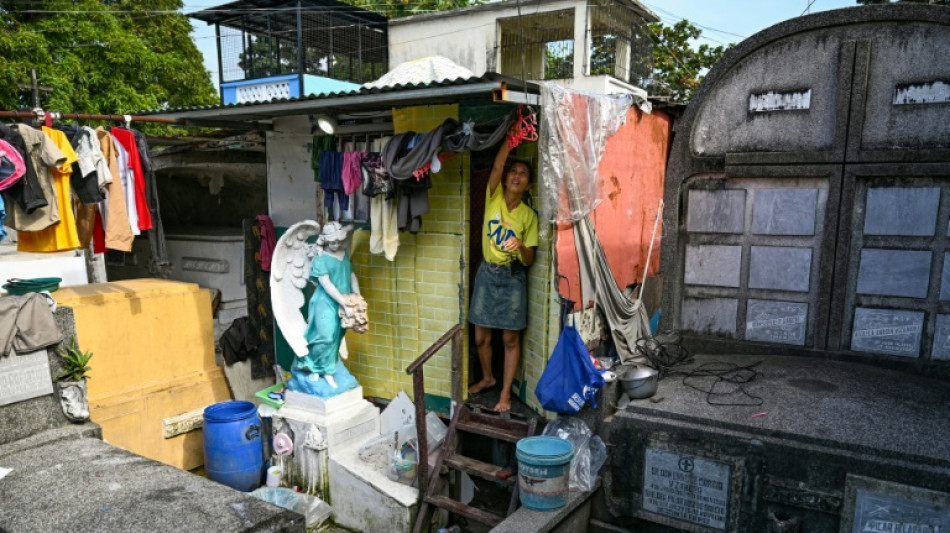
-
 Fentanyl, beans and Ukraine: Trump hails 'success' in talks with Xi
Fentanyl, beans and Ukraine: Trump hails 'success' in talks with Xi
-
'Nowhere to sleep': Melissa upends life for Jamaicans
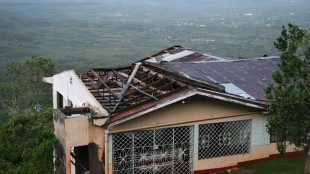
-
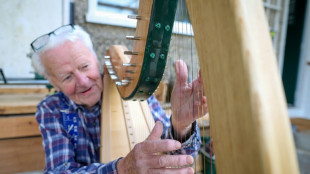 Irish octogenarian enjoys new lease on life making harps
Irish octogenarian enjoys new lease on life making harps
-
Tanzania blackout after election chaos, deaths feared

-
 G7 meets on countering China's critical mineral dominance
G7 meets on countering China's critical mineral dominance
-
Trump hails tariff, rare earth deal with Xi

-
 Court rules against K-pop group NewJeans in label dispute
Court rules against K-pop group NewJeans in label dispute
-
India's Iyer says 'getting better by the day' after lacerated spleen

-
 Yesavage fairytale carries Blue Jays to World Series brink
Yesavage fairytale carries Blue Jays to World Series brink
-
Bank of Japan keeps interest rates unchanged

-
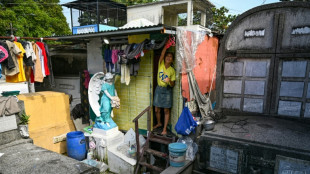 Impoverished Filipinos forge a life among the tombstones
Impoverished Filipinos forge a life among the tombstones
-
Jokic posts fourth straight triple-double as Nuggets rout Pelicans

-
 UN calls for end to Sudan siege after mass hospital killings
UN calls for end to Sudan siege after mass hospital killings
-
Teenage Australian cricketer dies after being hit by ball

-
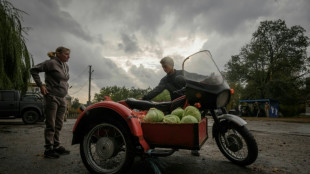 As Russia advances on Kupiansk, Ukrainians fear second occupation
As Russia advances on Kupiansk, Ukrainians fear second occupation
-
Trade truce in balance as Trump meets 'tough negotiator' Xi

-
 China to send youngest astronaut, mice on space mission this week
China to send youngest astronaut, mice on space mission this week
-
Yesavage gem carries Blue Jays to brink of World Series as Dodgers downed

-
 With inflation under control, ECB to hold rates steady again
With inflation under control, ECB to hold rates steady again
-
Asia stocks muted with all eyes on Trump-Xi meeting

-
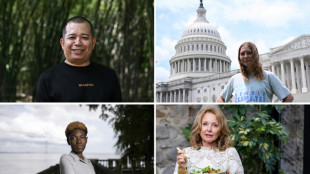 Personal tipping points: Four people share their climate journeys
Personal tipping points: Four people share their climate journeys
-
Moto3 rider Dettwiler 'no longer critical' after crash: family

-
 US economy in the dark as government shutdown cuts off crucial data
US economy in the dark as government shutdown cuts off crucial data
-
Trump orders nuclear testing resumption ahead of Xi talks

-
 'Utter madness': NZ farmers agree dairy sale to French group
'Utter madness': NZ farmers agree dairy sale to French group
-
Samsung posts 32% profit rise on-year in third quarter

-
 30 years after cliffhanger vote, Quebec separatists voice hope for independence
30 years after cliffhanger vote, Quebec separatists voice hope for independence
-
Taxes, labor laws, pensions: what Milei wants to do next

-
 South Sudan's blind football team dreams of Paralympic glory
South Sudan's blind football team dreams of Paralympic glory
-
US says 4 killed in new strike on alleged Pacific drug boat

-
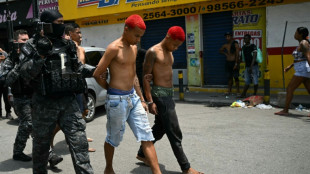 What we do and don't know about Rio's deadly police raid
What we do and don't know about Rio's deadly police raid
-
'They slit my son's throat' says mother of teen killed in Rio police raid
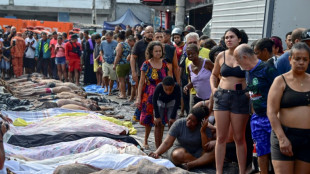
-
 Arteta hails 'special' Dowman after 15-year-old makes historic Arsenal start
Arteta hails 'special' Dowman after 15-year-old makes historic Arsenal start
-
Google parent Alphabet posts first $100 bn quarter as AI fuels growth

-
 Underwater 'human habitat' aims to allow researchers to make weeklong dives
Underwater 'human habitat' aims to allow researchers to make weeklong dives
-
Maresca slams Delap for 'stupid' red card in Chelsea win at Wolves

-
 'Non-interventionist' Trump flexes muscles in Latin America
'Non-interventionist' Trump flexes muscles in Latin America
-
Slot defends League Cup selection despite not meeting 'Liverpool standards'

-
 'Poor' PSG retain Ligue 1 lead despite stalemate and Doue injury
'Poor' PSG retain Ligue 1 lead despite stalemate and Doue injury
-
Kane nets twice in German Cup as Bayern set European wins record

-
 Liverpool crisis mounts after League Cup exit against Palace
Liverpool crisis mounts after League Cup exit against Palace
-
Juve bounce back after Tudor sacking as Roma, Inter keep pace with leaders Napoli

-
 Kane scores twice as Bayern set European wins record
Kane scores twice as Bayern set European wins record
-
Radio Free Asia suspends operations after Trump cuts and shutdown

-
 Meta shares sink as $16 bn US tax charge tanks profit
Meta shares sink as $16 bn US tax charge tanks profit
-
Dollar rises after Fed chair says December rate cut not a given

-
 Google parent Alphabet posts first $100 bn quarter as AI drives growth
Google parent Alphabet posts first $100 bn quarter as AI drives growth
-
Rob Jetten: ex-athlete setting the pace in Dutch politics

-
 Juve bounce back after Tudor sacking as Roma keep pace with leaders Napoli
Juve bounce back after Tudor sacking as Roma keep pace with leaders Napoli
-
Favorite Sovereignty scratched from Breeders' Cup Classic after fever


Impoverished Filipinos forge a life among the tombstones
In teeming Manila, where poverty runs deep and millions lack adequate shelter, some of the living have found refuge among the dead.
Laileah Cuetara's shanty sits atop a pair of raised tombs inside the Philippine capital's Manila North Cemetery, a sprawling 54-hectare public graveyard that is home to about 6,000 informal settlers and at least a million deceased Filipinos.
The tiny wood structure where she lives with her partner and two children is filled from side to side with a foam mattress, shelves, a television and picture frames. In the doorway, a statue of an angel stands on an infant's crypt that doubles as a table.
The 36-year-old makes around 3,000 pesos ($51) a month selling sweets, drinks and biscuits to cemetery visitors.
Over All Saints' Day and All Souls' Day, when millions of Filipinos visit the graves of departed loved ones, she and her partner receive up to 1,700 pesos for each of the 30 tombs they clean and tend to throughout the year.
But the money they earn is far too little to move, she said ahead of the November 1-2 holidays.
"With the high prices of basic goods nowadays, it's very difficult to improve our living conditions," said Cuetara, who moved into the cemetery in 2008 after a family conflict forced her from her home in the Manila suburbs.
A former Filipino congressman this year estimated three million people lacked adequate housing in Metro Manila, while a 2023 United Nations report predicted as many as 22 million across the archipelago nation could face that predicament by 2040.
- Dreaming of a house -
For 51-year-old Priscilla Buan, who was born inside the graveyard and has raised her children among the tombs, nothing is more terrifying than the demolition orders that follow occasional complaints from visitors.
"Whenever we hear about demolition orders, we remove our belongings... We hide (the appliances) in a different mausoleum so they won't be seen," the third-generation dweller told AFP, saying demolitions happen at least once a year.
Buan and her family of four sleep atop two crypts in a mausoleum. The remaining area has been repurposed into a living room complete with a sofa, cabinet and appliances. She sells snacks and small goods from the tomb's grilled window.
"Even if I wanted to, we don't have money to buy a house," Buan said.
But there has been a "concerning" increase in the number of cemetery dwellers, said Vicente Eliver of the Kapatiran-Kaunlaran Foundation, which has been providing livelihood and educational programmes to the graveyard residents since 2010.
Only the grave caretakers and their families once lived there, Eliver told AFP.
"But their children got married, had kids and grandkids who also decided to live inside the cemetery," he said.
Most of those living inside the cemetery say they have permission to occupy mausoleums or build shanties on top of graves in exchange for keeping them clean.
They tap into existing power lines for electricity and pay 3 pesos per gallon of water from nearby wells.
But the cemetery director, Daniel Tan, told AFP the informal arrangement was not meant to be a long-term one.
"This is a cemetery, it's for the dead and not for the living, so people are really not allowed to live here," he said.
"We allow (the caretakers) because of the mausoleums that they have to maintain. We just regulate them," said Tan, adding the city was attempting to find permanent homes elsewhere but offering no specifics.
Cuetara, who showed AFP a permission letter from the owner of the tomb where she resides, said living inside the cemetery was no one's first choice.
Her 11-year-old son has faced bullying at school over the family's address, while her six-year-old daughter is forever drawing houses that adorn the inside of their makeshift dwelling.
"I also want to live outside (the cemetery)... who doesn't?" Cuetara said.
"All of us here dream of having a house outside, but... it's hard, very hard."
V.Said--SF-PST

